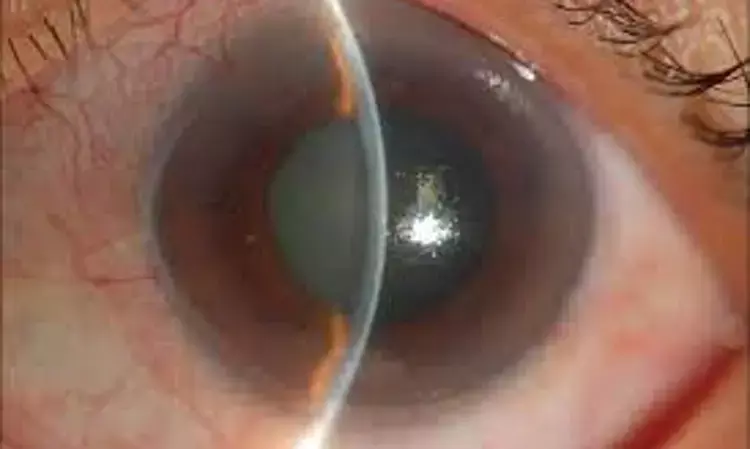- Home
- Medical news & Guidelines
- Anesthesiology
- Cardiology and CTVS
- Critical Care
- Dentistry
- Dermatology
- Diabetes and Endocrinology
- ENT
- Gastroenterology
- Medicine
- Nephrology
- Neurology
- Obstretics-Gynaecology
- Oncology
- Ophthalmology
- Orthopaedics
- Pediatrics-Neonatology
- Psychiatry
- Pulmonology
- Radiology
- Surgery
- Urology
- Laboratory Medicine
- Diet
- Nursing
- Paramedical
- Physiotherapy
- Health news
- Fact Check
- Bone Health Fact Check
- Brain Health Fact Check
- Cancer Related Fact Check
- Child Care Fact Check
- Dental and oral health fact check
- Diabetes and metabolic health fact check
- Diet and Nutrition Fact Check
- Eye and ENT Care Fact Check
- Fitness fact check
- Gut health fact check
- Heart health fact check
- Kidney health fact check
- Medical education fact check
- Men's health fact check
- Respiratory fact check
- Skin and hair care fact check
- Vaccine and Immunization fact check
- Women's health fact check
- AYUSH
- State News
- Andaman and Nicobar Islands
- Andhra Pradesh
- Arunachal Pradesh
- Assam
- Bihar
- Chandigarh
- Chattisgarh
- Dadra and Nagar Haveli
- Daman and Diu
- Delhi
- Goa
- Gujarat
- Haryana
- Himachal Pradesh
- Jammu & Kashmir
- Jharkhand
- Karnataka
- Kerala
- Ladakh
- Lakshadweep
- Madhya Pradesh
- Maharashtra
- Manipur
- Meghalaya
- Mizoram
- Nagaland
- Odisha
- Puducherry
- Punjab
- Rajasthan
- Sikkim
- Tamil Nadu
- Telangana
- Tripura
- Uttar Pradesh
- Uttrakhand
- West Bengal
- Medical Education
- Industry
Bilateral implantation of trifocal IOLs optimal option for correcting presbyopia: JAMA

Bilateral implantation of trifocal IOLs optimal option for correcting presbyopia suggests a recent study published in the JAMA Ophthalmology
A Bayesian network meta-analysis (NMA) can help compare the various types of multifocal and monofocal intraocular lenses (IOLs) used in clinical practice.
A study was done to compare outcomes of presbyopia-correcting IOLs frequently recommended in clinical practice through a bayesian NMA based on a systematic review.
Based on the research question, randomized clinical trials assessing multifocal IOLs in patients who underwent bilateral cataract extraction were searched. Nonrandomized studies, studies in patients with unilateral or contralateral cataract extractions, duplicated studies, conference abstracts, and nonpeer-reviewed articles were excluded.
Results:
- This NMA included 27 studies comprising 2605 patients.
- For uncorrected near visual acuity, trifocal IOLs and old bifocal diffractive IOLs afforded better visual acuity than monofocal IOLs.
- Regarding uncorrected intermediate visual acuity, extended depth-of-focus IOLs provided better visual acuity than monofocal IOLs.
- However, there were no differences between extended depth-of-focus and trifocal diffractive IOLs in pairwise comparisons.
- For uncorrected distant visual acuity, all multifocal IOLs were comparable with monofocal IOLs. There were no statistical differences between multifocal and monofocal IOLs regarding contrast sensitivity, glare, or halos.
Thus, for patients considering a multifocal IOL due to presbyopia, bilateral implantation of a trifocal IOL might be an optimal option for patients without compromising distant visual acuity.
Reference:
Cho J, Won YK, Park J, et al. Visual Outcomes and Optical Quality of Accommodative, Multifocal, Extended Depth-of-Focus, and Monofocal Intraocular Lenses in Presbyopia-Correcting Cataract Surgery: A Systematic Review and Bayesian Network Meta-analysis. JAMA Ophthalmol. Published online September 22, 2022. doi:10.1001/jamaophthalmol.2022.3667
Keywords:
Bilateral, implantation, trifocal, IOLs, optimal, option, correcting, presbyopia, JAMA Ophthalmology, Cho J, Won YK, Park J, Visual Outcomes, Optical Quality, Accommodative, Multifocal, Extended Depth-of-Focus, and Monofocal Intraocular Lenses
Dr. Shravani Dali has completed her BDS from Pravara institute of medical sciences, loni. Following which she extensively worked in the healthcare sector for 2+ years. She has been actively involved in writing blogs in field of health and wellness. Currently she is pursuing her Masters of public health-health administration from Tata institute of social sciences. She can be contacted at editorial@medicaldialogues.in.
Dr Kamal Kant Kohli-MBBS, DTCD- a chest specialist with more than 30 years of practice and a flair for writing clinical articles, Dr Kamal Kant Kohli joined Medical Dialogues as a Chief Editor of Medical News. Besides writing articles, as an editor, he proofreads and verifies all the medical content published on Medical Dialogues including those coming from journals, studies,medical conferences,guidelines etc. Email: drkohli@medicaldialogues.in. Contact no. 011-43720751


